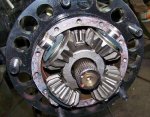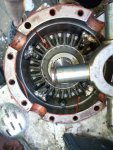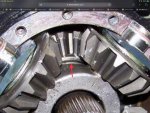coachgeo
Well-known member
- 4,985
- 3,346
- 113
- Location
- North of Cincy OH
@Xengineguy .... your front and rear ECO are the same design correct?
for poe folk:
aka- you have more time than money....
IMHO !!!! at your own risk
- wonder if one could only use a pair of ECO hubs? (if he is wiling to only sell a pair)
- pull your front drive shaft....
- put the ECO hubs in the rear only..
- drive in mode ONLY. Even with 5 gears of mode you will be fine with this set up*.
-- switch back to your OEM pair of hubs and reinstall drive shaft when your going off roading or hard pulling where AWD or 4wd will be needed. Give your Trans time to relearn again of course.
For more poor folk that are experienced grind a weld types ..... one can consider get same effect effect (if it that won't knacker then transmisson) by Lincoln locking two spare hubs.... Swap them in like above.. If time and experimenting makes you trust your Lincoln weld job, do all four hubs.
* Fellow bought my truck from did this. but only Lincoln locked front hubs. Pulled rear drive axles (rear pinion had an issue is why did this) put it in Mode (aka... front wheel drive) and drove from south GA to mid. MO at 70mph in AO without issue in 5th gear. Kept it that way for a year as he drove it around home town in MO... That said...... he is a welder by trade. BIG TIME welder... like oil rigs, Alaskan oil tankers, and other high responsibility/high liability type welding. He did the weld with a borrowed welding machine at a small shop in GA though. Not sure if he used stick or wire feed. For him it was a choice of find a welding maching to use or drive 30mph for rest of trip from there to MO. He found a welder to borrow.
Later dissection of transmission for other reasons, showed this front wheel drive mode trip put no undue wear on the trans. clutches. Still though I would not recommend that. Rear drive is direct drive via gears out of trans.... would not put strain on clutches like front wheel drive only would.
for poe folk:
aka- you have more time than money....
IMHO !!!! at your own risk
- wonder if one could only use a pair of ECO hubs? (if he is wiling to only sell a pair)
- pull your front drive shaft....
- put the ECO hubs in the rear only..
- drive in mode ONLY. Even with 5 gears of mode you will be fine with this set up*.
-- switch back to your OEM pair of hubs and reinstall drive shaft when your going off roading or hard pulling where AWD or 4wd will be needed. Give your Trans time to relearn again of course.
For more poor folk that are experienced grind a weld types ..... one can consider get same effect effect (if it that won't knacker then transmisson) by Lincoln locking two spare hubs.... Swap them in like above.. If time and experimenting makes you trust your Lincoln weld job, do all four hubs.
* Fellow bought my truck from did this. but only Lincoln locked front hubs. Pulled rear drive axles (rear pinion had an issue is why did this) put it in Mode (aka... front wheel drive) and drove from south GA to mid. MO at 70mph in AO without issue in 5th gear. Kept it that way for a year as he drove it around home town in MO... That said...... he is a welder by trade. BIG TIME welder... like oil rigs, Alaskan oil tankers, and other high responsibility/high liability type welding. He did the weld with a borrowed welding machine at a small shop in GA though. Not sure if he used stick or wire feed. For him it was a choice of find a welding maching to use or drive 30mph for rest of trip from there to MO. He found a welder to borrow.
Later dissection of transmission for other reasons, showed this front wheel drive mode trip put no undue wear on the trans. clutches. Still though I would not recommend that. Rear drive is direct drive via gears out of trans.... would not put strain on clutches like front wheel drive only would.
Last edited:






